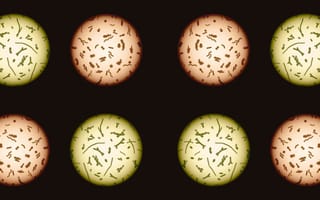A leading treatment for one of the most devastating digestive conditions is, in one sense, the definition of “crappy” and, in another sense, the polar opposite.
Fecal microbiota transplants (FMTs) are literally made of poop — human stool from a healthy person is administered to an ill patient via colonoscopy, enema or pills. The treatment has shown promising results against all kinds of nasty conditions, but it’s proven most effective so far against C. difficile, or C. diff, a bacterial infection that can cause excruciating abdominal pain and diarrhea. Indeed, some experts place the cure rate for FMTs against C. diff between 80 and 90 percent.
What Are Fecal Microbiota Transplants?
But despite its success, FMT administration has been complicated by a variety of factors. Those include a murky regulatory framework, an insurance industry loath to cover the procedure, and escalating costs, as donor stool has to be screened for an ever-growing list of pathogens, now including COVID-19.
For years, stool banks, which collect and prep stool donations, have largely found ways to navigate these issues, though not altogether. After suspending FMT shipments for months due to coronavirus, the country’s major stool bank, OpenBiome, announced in February that it’s ramping down FMT operations, a move hastened by COVID-related costs.
Now, the treatment landscape is on the precipice of a major sea change. Three biotech companies — Seres Therapeutics, Finch and Rebiotix — have developed drugs that could be the first microbiome therapies approved by the FDA in treatment for recurrent C. diff. (Seres and Rebiotix announced strong results — the former from Phase 3 trials, the latter from interim open-label trials — at last month’s Digestive Disease Week.) A fourth company, Vedanta, whose treatment approach is perhaps the most revolutionary, isn’t far behind. The first of the candidates could be approved as soon as next year.
That’s generated both excitement, for the promise of new treatments, and a trace of unease, over what role the stool bank system will have left to play in treating C. diff.

Where Will FMT Fit?
Libby Hohmann, for one, carries a mix of both sentiments. Hohmann is helping run the open-label study for the C. diff drug candidate developed by Seres Therapeutics, called SER-109. For SER-109, Seres starts with donor stool, then uses ethanol to kill off bad bacteria, fungi and viruses, leaving good spores from a single active bacterial strain, which are put into a suspension before going into pills. That intentional decontamination is “a real plus,” said Hohmann, who’s feeling “cautiously optimistic” about the emerging therapies as a whole.
At the same time, Hohmann also heads up the FMT stool bank at Massachusetts General Hospital (Mass General). She’s concerned about what the advent of commercial products might mean for her own operations. Hohmann suspects it’d be the end of FMTs for C. diff at her bank. That might seem moot if commercial options become available, but drug pricing — and to what extent insurance will cover the drugs, if approved — remains unsettled.
“What about destitute people who have no insurance?” said Hohmann.
No company has shared pricing plans, but some could be steep. Chris Howerton, a research equity analyst at Jeffries, specializes in covering microbiome biotech companies. He said Seres could charge between $10,000 and $12,000 per year per patient for second- or third-line treatment for recurrent C. diff. Finch, which could position its treatment as a first-line option after antibiotics, would need to price that drug at (at least) $5,000 to cover production costs.
Even for those with insurance, pricey drugs could mean delayed access. Colleen Kelly is a gastroenterologist and associate professor of medicine at Brown University who treats patients using FMT. She fears that high prices may lead payers to require patients to go on prolonged courses of vancomycin, a first-line antibiotic treatment for severe C. diff, before covering new drugs. She also sees a continued need for FMT for patients who are unable to swallow pills, for those who fail the new treatments and for pediatric patients.
“There will be a small group of people who probably will still need conventional FMT,” she said. “I don’t want to see that go away completely.”
Right now the FDA exercises enforcement discretion for FMT administration to patients with recurrent, unresponsive C. diff. That means doctors don’t have to undertake the costly, time-consuming process of securing an investigational new drug (IND) permit. Experts suspect the FDA will end that discretion once drugs become available.
“I would really hate to see them completely pull back and close the door on enforcement discretion, and force us to use the [new] products without any other recourse,” said Kelly.
The other alternative is the do-it-yourself approach, which some desperate patients — despite obvious risks — continue to take. On online FMT support groups, many users also report buying FMTs from overseas, for a variety of conditions. But even that can be costly — one popular source charges $1,900, with shipping, for six enema bottles, and it doesn’t have the respected reputation of OpenBiome. Plus people are still left to self-administer.

Instability of the Stool Bank System
OpenBiome, the nation’s first public stool bank, will stop supplying FMTs in the near future. It has enough FMT inventory on hand to support C. diff patients at least through 2021, and will support some clinical trials that run through 2022.
OpenBiome always felt it would be too costly to continue providing FMTs once FDA-approved alternatives arrived, according to executive director Carolyn Edelstein. But it hoped the arrival timeline, and the scale at which new drugs would be available, would be a bit clearer as it ramped down.
“But then COVID happened, of course,” said Edelstein.
COVID slammed the brakes on most FMT delivery. From the pandemic’s onset through April of this year, OpenBiome only shipped treatments for emergency cases. The pause highlighted the vulnerability of the stool bank system.
It was something of a turning point for doctors like Kelly, who had sourced FMTs from OpenBiome and was unable to administer the treatment for more than a year. (She now sources from a bank based at University of Minnesota.) Despite having reservations about certain potential shortcomings under a new treatment landscape, she now feels “almost a sense of relief” at the greater stability promised by sanctioned therapies, after having experienced the COVID disruption, she said.
The pause was a major roadblock for the stool bank system, but not the first. Even before COVID, the minimal screening requirements had been increasing. Dozens of pathogens now must be screened. That contributed to higher costs: An FMT dose from OpenBiome cost about $600 in 2016; by 2019, it was nearly $1,900. And remember, insurance companies are generally not eager to cover FMTs. Mass General and Brown both eat the costs, rather than sticking it to patients.
Most dramatically, the FDA issued two safety alerts following one death and seven serious infections in patients who received FMTs. In 2019, one FMT patient died and another fell ill being exposed to extended-spectrum beta-lactamase (ESBL)-producing E. coli. In 2020, two patients developed infections caused by a virulent strain of E. coli, and four were infected due to a different virulent E. coli strain.
The 2019 patients were immunocompromised, and protocols now screen for the bacteria that led to the infections. And the number of stricken was small compared to the total number of FMTs administered. (OpenBiome shipped tens of thousands of doses per year before the pandemic halt.) Still, the episodes provided grist for those who consider the therapy risky.
The Drug-Maker Players
A helpful way to think about the emerging treatments is by degree of manipulation: How close or far away from conventional FMT is the drug? How much intervention is involved? In short, two are pretty close to FMT, one is fully divorced from donor stool, and a fourth lands somewhere in between.

Rebiotx’s drug, RBX2660, is close to FMT. It’s derived from a whole donor stool, then buffered and cryopreserved in an enema bag. (The other companies’ offerings are pills. Rebiotix is also developing an oral option for C. diff, which has completed Phase 1 trials.) RBX2660 “preserves as much of the entire microbiota” from the donor sample “as possible,” said Ken Blount, chief scientific officer of Rebiotix — which depending on who you ask and what condition is being treated may be a key consideration.
Unlike some non-oral FMTs, RBX2660 doesn’t require a colonoscopy or bowel prep. And each step in the manufacturing process is standardized, which the FDA will surely smile upon, Blount said.
On the other hand, the enema delivery system — which will be administered in a healthcare setting — is a significant downside compared to exclusively pill-focused competitors, Howerton, the analyst who tracks the microbiome therapies space, said. But it’s worth noting that RBX2660 would also seem to be a viable option for patients who have difficulty swallowing.
Finch’s C. diff candidate, CP101, also comes from donor stool and delivers the full microbial community, but in pills, and after different intervention. The stool sample is buffered, freeze-dried into a powder, then encapsulated.
By the way, if a pharmaceutical drug built upon human stool sounds odd, that’s because it is. The FDA created a new drug category, called live biotherapeutic products (LBPs) to accommodate drugs that incorporate live microorganisms. No LBP has yet been approved, but a C. diff treatment might be the first.
Notably, Finch has a partnership with OpenBiome, which gives them access to large, valuable data sets. Also important: Finch has the ability to develop drugs that are either donor-derived, lab-grown (individual microbes are fermented in master cell banks, with no stool sample involved), or a mix of both. The company uses a machine learning platform to home in on the precise organisms and mechanics that are delivering good results, then determines which approach is best for a given condition.
“The ability to leverage the clinical data and this reverse engineering platform enable us to retire significant risks before we initiate development,” said Mark Smith, CEO of Finch, in a presentation last month.
While Finch's CP101 is donor-derived and contains the complete microbiota, its ulcerative colitis drug candidate is derived from lab-grown material, and its autism disorder candidate is a combination of the two. (The ulcerative colitis and autism drugs are both in preclinical stages.)

Matthew Henn, chief scientific officer at Seres Therapeutics, describes what sounds like a similar process at Seres. The company’s discovery platform is also what’s called reverse translational — meaning it works backward from patient experiences (and animal models) to pinpoint the effective microbes and mechanisms to treat an indication.
Seres analyzes microbiome changes in human-trial participants, with ML-assisted analysis, and interprets those findings against a broader library of bacteria and their various effects, gleaned through different assays. “It’s through the aggregate of all of that work and data that we seek to identify what we see as the active bacteria that are relevant,” Henn said.
Like Finch, some drugs in Seres’ pipeline are derived from stool donors (SER-109, for C. diff) and others hinge on lab-grown bacteria (a graft-versus-host-disease drug, which was granted IND clearance early this month, and an ulcerative colitis drug, in Phase 1 trials).
The other company in play, Vedanta, has, in a sense, fully wiped its hands of poo. Unlike competitors, even Vedanta’s C. diff drug candidate, VE-303, eschews donor samples. Most notably, all of Vedanta’s drugs are made from what's called a designed consortia — or a combination of several lab-fermented bacterial strains. (VE-303 has eight strains.) That kind of manufactured mixture of bacteria is “the holy grail,” said Hohmann, of Mass General.
Howerton, the equity research analyst, agreed that manufactured consortia — along with lab-grown single-microbe drugs — are the future of the field, but noted that Vedanta will likely be playing catch-up in a market saturated with multiple competing drug options by the time VE-303 becomes available. A company like Finch, meanwhile, can generate cash flow with it’s admittedly more traditional freeze-dried-stool pill, but then use that money to propel R&D for more manufactured or hybrid approaches, Howerton noted.
Some Skepticism on the Ground
Despite the range of approaches, gastroenterologist Alexander Khoruts, who directs the University of Minnesota’s stool donation bank, is skeptical of the emerging C. diff therapies. The issue? The drugs solve a problem that FMT had already tackled, he said.

Khoruts is doubtful that the treatments will offer an appreciable advantage over FMT. Indeed, the most recent efficacy figures, presented at Digestive Disease Week by Seres and Rebiotix, were lower than the 90 percent cure rate sometimes ascribed to FMT. (SER-109 had a sustained clinical response rate of 88 percent at eight weeks and 79 percent at 24 weeks; 75 percent of those enrolled in the open-label RBX2660 study — less restrictive and therefore more closely mimicking real-world practice than more controlled studies — had no C. diff after eight weeks.)
That said, representatives from both companies stressed that a comparison between their clinical trials and a meta-analysis of pooled FMT studies is essentially apples to oranges. Henn, of Seres, said that Finch’s Phase 2 data, which showed sustained clinical response of 75 percent, is actually the best data window into the efficacy of FMT treatments.
Since 2018, the AGA Fecal Microbiota Transplantation National Registry has been tracking FMT recipients, with the goal of better understanding the long- and short-term efficacy and safety of the procedure. The AGA follows up with recipients annually and will do so for up to 10 years. Once LBPs are on the market, the registry will also track participating LBP recipients, which will allow experts to compare the approaches across similar patient populations.
Khoruts is also skeptical of the “holy grail” approach. To assume that combinations of lab-fermented bacteria strains are better or safer than FMTs may be biased by “scientific arrogance,” he said.
“That thinking ignores that we don't live in a germ-free bubble,” Khoruts said. “The question is not just what are you putting in, but what comes out? Two months later, one year later, what’s the microbial community?”
“There were generations of children who were raised with the idea that formula is better than breast milk,” he added.
But even if the drugs aren’t markedly better than FMT, doesn’t the fragility of the donor bank system necessitate them? Not if the FDA were to regulate the stool banks the same way it does blood banks, said Khoruts.
Blood banks also face the challenge of screening for novel pathogens, but their regulatory clarity lends them greater stability and controlled costs. To that point, in 2019, researchers at a university hospital in Denmark illustrated how FMT services could work within the existing infrastructure of blood centers.
The Australian model is also of note. The Therapeutic Goods Administration (Australia’s equivalent to the FDA) created a new regulatory model for FMTs that distinguishes between — and provides guidance for — both FMTs that are prepared in a healthcare environment and “minimally manipulated” FMTs manufactured outside a healthcare setting. The framework spells out donor screening and stool testing requirements — codifying the best practices already observed by good actors in the FMT space — and paves the way for a more complete role for FMT and stool banks going forward.
Such a framework wouldn’t seem impossible in the U.S. Drugs like those from Finch and Rebiotix aren’t too far removed from FMTs, and will likely be submitted as LBPs — which are still considered biologics by the FDA, as is blood. But the agency has yet to signal an appetite for such a move.
To be sure, even if the FDA lifts enforcement discretion around C. diff, as experts expect, the remaining stool banks in the U.S. will still be able to supply FMTs for other conditions through research projects under IND permits. That, however, means less direct impact while still facing the financial and logistical challenges of “experimental” operations.
COVID showed that less reliance on stool banks, as they’re allowed to exist in the U.S., has major, undeniable advantages, but doctors like Khoruts don't want their stature to diminish too much.
“I think it’s probably in the public interest to maintain both models, to create a bit of competition and make sure that some company isn’t going to come down and claim intellectual property on what nature has created,” Khoruts said.




